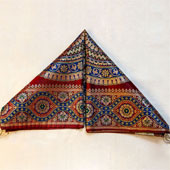Design Resource
Himroo Weaving - Aurangabad, Maharashtra
Art of Weaving Figure Fabric
by
In earlier times the himroo weaving was done with minimum of two people, one weaver for different colour threads and another person to pull the strings of the loom. At present many weavers have switched on the power loom. Before weaving the design has to be decided since it is an output of two kinds of yarns. The looms are pit raised looms operated by the power and have four vertical poles at each corner with a wooden frame above. The warp yarns are passed through the arrangements of the frame of the loom. Then the yarns are passed through the four heddle shaft which is held by traditional method with containers having sand of the required quantity and iron rods to give the tension on the shafts for the easy movement of the yarns for the interlacement. The heddles are operated with pedals which are at a slant position in the pit. The weft yarn is inserted by the throw shuttle with different colors as per the pattern of design to be obtained. Only few weavers even today weave the himroo fabrics by hand as many of them have switched on to the mass production with machines where the designs are inserted on the punch cards. It takes minimum of seven to ten days to weave the shawl which usually measure about two meters of length. The cotton and the artificial silk yarns are usually purchased from Malegaon and pure silk from Bengaluru.













